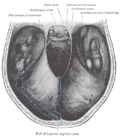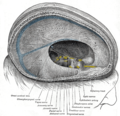Diaphragma sellae
Diaphragma sellae is a small, circular sheet of dura mater that forms the roof of the sella turcica, a saddle-shaped depression in the sphenoid bone of the human skull. It is a significant anatomical structure in the central nervous system and plays a crucial role in protecting the pituitary gland, which is located directly beneath it.
Anatomy[edit]
The diaphragma sellae is a horizontal extension of the dura mater, the outermost layer of the meninges, the protective coverings of the brain and spinal cord. It is located in the middle cranial fossa, covering the sella turcica. The diaphragma sellae has a small opening in its center to allow for the passage of the pituitary stalk, which connects the pituitary gland to the hypothalamus of the brain.
Function[edit]
The primary function of the diaphragma sellae is to protect the pituitary gland. By forming a barrier between the gland and the subarachnoid space, it prevents the cerebrospinal fluid from reaching the pituitary gland. This is important because the pituitary gland is responsible for the production and release of several vital hormones, including growth hormone, thyroid-stimulating hormone, and adrenocorticotropic hormone.
Clinical significance[edit]
In some cases, a pituitary adenoma, a benign tumor of the pituitary gland, can grow large enough to push against the diaphragma sellae, causing it to bulge upward. This can lead to a condition known as empty sella syndrome, characterized by a range of symptoms including headaches, vision problems, and hormonal imbalances. The diaphragma sellae is also an important landmark in transsphenoidal surgery, a minimally invasive surgical procedure used to remove pituitary tumors.
See also[edit]
-
Diaphragma sellae
-
Diaphragma sellae
-
Diaphragma sellae
Ad. Transform your life with W8MD's Budget GLP-1 injections from $75


W8MD offers a medical weight loss program to lose weight in Philadelphia. Our physician-supervised medical weight loss provides:
- Weight loss injections in NYC (generic and brand names):
- Zepbound / Mounjaro, Wegovy / Ozempic, Saxenda
- Most insurances accepted or discounted self-pay rates. We will obtain insurance prior authorizations if needed.
- Generic GLP1 weight loss injections from $75 for the starting dose.
- Also offer prescription weight loss medications including Phentermine, Qsymia, Diethylpropion, Contrave etc.
NYC weight loss doctor appointmentsNYC weight loss doctor appointments
Start your NYC weight loss journey today at our NYC medical weight loss and Philadelphia medical weight loss clinics.
- Call 718-946-5500 to lose weight in NYC or for medical weight loss in Philadelphia 215-676-2334.
- Tags:NYC medical weight loss, Philadelphia lose weight Zepbound NYC, Budget GLP1 weight loss injections, Wegovy Philadelphia, Wegovy NYC, Philadelphia medical weight loss, Brookly weight loss and Wegovy NYC
|
WikiMD's Wellness Encyclopedia |
| Let Food Be Thy Medicine Medicine Thy Food - Hippocrates |
Medical Disclaimer: WikiMD is not a substitute for professional medical advice. The information on WikiMD is provided as an information resource only, may be incorrect, outdated or misleading, and is not to be used or relied on for any diagnostic or treatment purposes. Please consult your health care provider before making any healthcare decisions or for guidance about a specific medical condition. WikiMD expressly disclaims responsibility, and shall have no liability, for any damages, loss, injury, or liability whatsoever suffered as a result of your reliance on the information contained in this site. By visiting this site you agree to the foregoing terms and conditions, which may from time to time be changed or supplemented by WikiMD. If you do not agree to the foregoing terms and conditions, you should not enter or use this site. See full disclaimer.
Credits:Most images are courtesy of Wikimedia commons, and templates, categories Wikipedia, licensed under CC BY SA or similar.
Translate this page: - East Asian
中文,
日本,
한국어,
South Asian
हिन्दी,
தமிழ்,
తెలుగు,
Urdu,
ಕನ್ನಡ,
Southeast Asian
Indonesian,
Vietnamese,
Thai,
မြန်မာဘာသာ,
বাংলা
European
español,
Deutsch,
français,
Greek,
português do Brasil,
polski,
română,
русский,
Nederlands,
norsk,
svenska,
suomi,
Italian
Middle Eastern & African
عربى,
Turkish,
Persian,
Hebrew,
Afrikaans,
isiZulu,
Kiswahili,
Other
Bulgarian,
Hungarian,
Czech,
Swedish,
മലയാളം,
मराठी,
ਪੰਜਾਬੀ,
ગુજરાતી,
Portuguese,
Ukrainian



